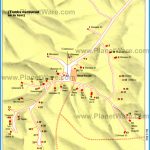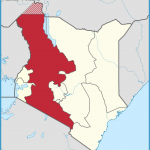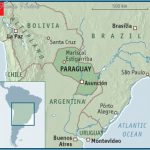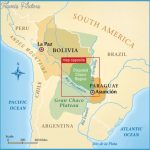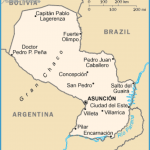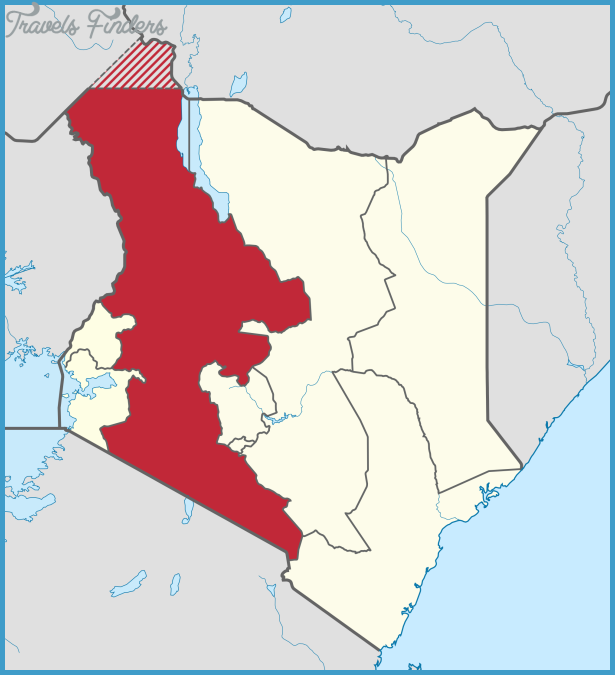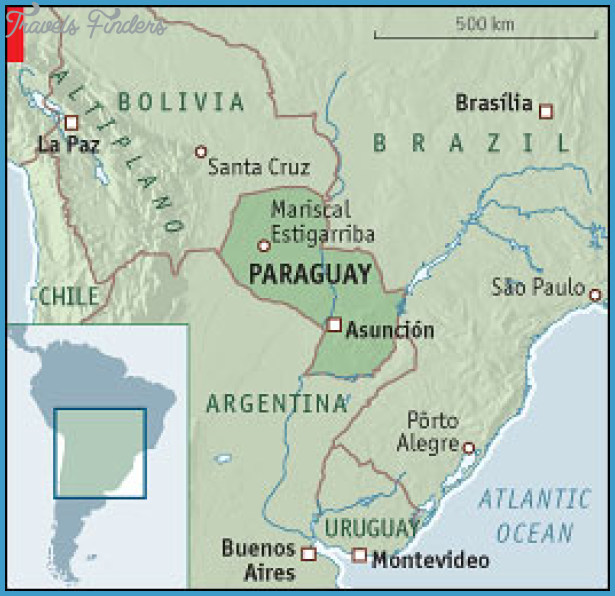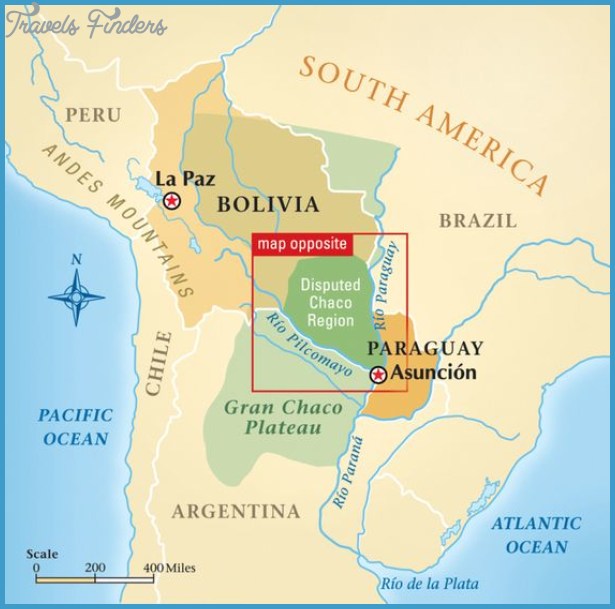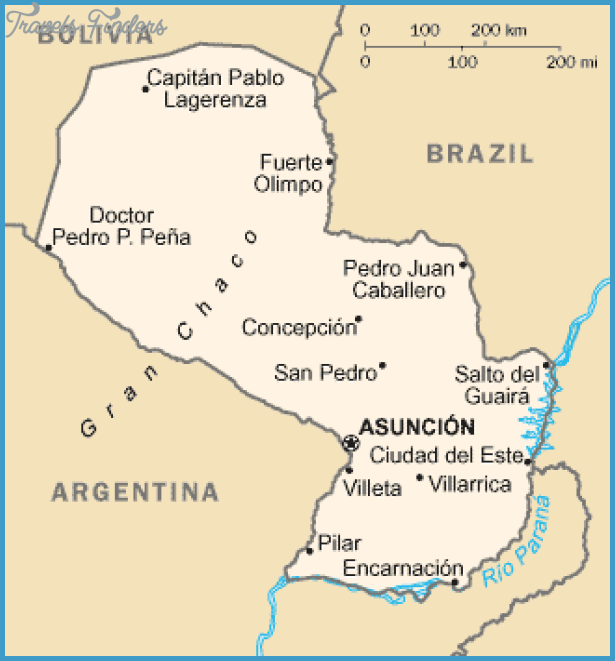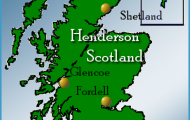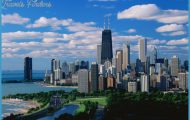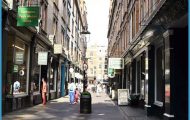Vallemi is one of the northern most cities in Eastern Paraguay. This curious and remote city is home to a series of recently discovered limestone caverns. The area’s inhabitants live mostly off the mining industry. Paraguay’s largest cement factory, the Industria Nacional de Cemento (INC), is located on the riverbanks just south of the city center. The factory’s large quarry is clearly visible on the left-hand side of the road when arriving in Vallemi. Those not employed by the INC work in small scale quarries mining dolomite, marble, and limestone or in lime manufacturing factories. This work is backbreaking as almost everything is done manually, from breaking rocks with sledgehammers to loading them on to cargo ships one wheelbarrow at a time over rickety planks. Vallemi is a very surprising town which at times can contrast greatly with its remote surroundings. Due to the presence of the INC the entire town is paved with cement. There are several nice plazas around town decorated with sculptures by local artist and INC worker Sebastian Amarilla. North past Vallemi the
Paraguay River begins a series of twists and turns winding its way up through the Paraguayan Pantanal towards the northern triple border with Brazil and Bolivia (see Traveling Along the Paraguay River).
While Vallemi may not merit a side trip all on its own it is a good way to break up a trip along the Paraguay River. Those returning from Bahia Negra can save themselves a full day on the passenger boat by stopping in Vallemi and continuing to Concepcion by bus. The same is true of the trip from Concepcion to Bahia Negra, however you may have to make previous arrangements with the boat captain if you want to reserve a cabin. Due to the town’s remote location expect to pay a premium for food and fuel.
Making Art out of Cement
Local artist and INC cement factory mechanic Sebastian Amarilla is responsible for the dynamic and expressive monuments in Vallemis many plazas. At the entrance to the INC is ” Gratitud al Supremo Dios” depicting a muscular man holding a loaf of bread and rocks aloft. According to the artist this symbolizes the way in which the residents of Vallenu have turned the area’s natural resources into their daily bread. In the middle of the Plaza de los Martires (Plaza of the Martyrs) along Calle Rio Paraguay is a highly evocative monument entitled Ninos martires de Acosta Nu depicting the surviving children of the Triple Alliance era battle of Acosta Nu (see Los Ninos Martires de Acosta Nu) working together to raise a tattered Paraguayan flag and rebuild the nation. Near the port of Vallemi is the new Plaza Flora y Fauna with a large multi piece sculpture in honor of the flora and fauna of the region. In the center is a fountain with a large dorado fish splashing out of the water. The surrounding sculptures depict birds and large animals of the region.
Lodging
Hotel El Prado Very clean and spotless, this is the nicest hotel in town, located along the river near Vallemi’s port. Tel: 0351 230 324, 230 545, Avenida General Bernardino Caballero about 500 meters from the port along the river. Gs. 56,000 per person. TV, AC
Hospedaje La Brazilera While not as nice as Hotel El Prado this family run hotel certainly has more character. Rooms are cheerfully decorated with murals and paintings of Pantanal landscapes as is the hotel’s restaurant. Owners are extremely friendly and can regale you with wild tales of fishing for sting rays in the Apa River. Very good Brazilian and Paraguayan food is available in the hotel’s restaurant (ask in advance if you would like to eat fish). Tel: 0351 230 636, Avenida Mariscal Lopez 125, hotelmeson.tripod.com, Double Gs. 90,000 with private bathroom, Gs. 70,000 with shared bathroom, A/C. Restaurant hours 7am-9pm, Gs. 15,000-
20,000
Food
El Triangulo A well stocked supermarket across from the large plaza by the main docks. A good place to stock up on supplies before boarding the Aquidaban or Cacique II. Tel: 0351 230 203, 0351 230232, Corner of Avenida Rw Paraguay and Primero de Mayo, daily 7am-12pm, 2pm-7pm
Caves of Vallemi & San Lazaro
There are several limestone caves in Vallemi and the nearby district of San Lazaro, most of which were discovered by adventurous employees of the INC cement factory. With stalactites of up to six meters in length the Santa Caverna is the most impressive cave, though for conservation purposes tours are generally limited to scientific expeditions. Discovered in 2006 the cave gets its name from a large stalagmite which is said to be shaped like the Virgin Mary (you will have to use your imagination to see the resemblance). Nearby is the Tres Cerros cave, which was the first to be discovered. Unfortunately many of its stalactites have been cut down by vandals. The Caverna San Lazaro, also known as Cantera 54 is easily accessed and has over fifteen large caves. The Calera Risso is a seventy-meter deep open roofed cave which is popular for rappelling. In addition to limestone formations all the caves have impressive tree roots penetrating through their ceilings and extending into the floor. Perhaps the easiest cave to visit is the Camba Hopo cave which is only 300 meters from the INC factory and accessed via a fifteen minute boat ride from Valleml’s port. The caves, most of which are on private property, must be visited with private guides who can provide safety equipment such as helmets and headlamps. Depending on your budget and how many people there are in your group you can choose to go by motorcycle or car. Be sure to bring plenty of mosquito repellant. Expect to pay between Gs. 250,000 to 300,000 per person if riding motorcycles and Gs. 400,000 per person if making the trip in a car. While making arrangements it is important to confirm which caves will be visited. With the exception of Camba Hopo caves are all accessed via dirt roads which can become impassable after rains. Adventurous tourists can also inquire with guides about the possibility of rappelling in Calera Risso, Caverna San Lazaro, or along the cliffs above Camba Hopo. For tours contact Francisco Narvaez (Tel: 0985 192510) who works for the INC and is credited with the discovery of the Santa Caverna, or Hugo Soilan (Tel: 0351 230 764) or Pedro Benitez (Tel: 0985 158 637, 0351 230 664), both of whom work for the tourism department of the Municipal Office. They can also arrange for tours of the INC cement factory.
Industria Nacional de Cemento
This cement processing plant, the county’s largest, produces most of the cement used in Paraguay. Visiting the factory you can see every stage of cement production. Limestone is first mined from the factory’s large quarry after which it is transported via conveyor belt to a large mill where it is crushed into a fine powder. The powder is mixed with additives before entering enormous cylindrical rotating kilns. Within the kilns, which are fired at 1000 degrees Celsius, the powder undergoes a multi-step process which causes it to fuse together into small pellets known as clinker. The final product is Portland Cement, which is the main ingredient in concrete. The tour’s highlight is getting a chance to peer through a window into the rotating kiln and see the clinker bouncing around inside. The clinker inside is white hot, so much so that you must wear a welder’s mask to protect your eyesight when looking in. The INC factory is located about 1.7 kilometers downriver from Vallemi s port. Follow Avenida General Bernardino Caballero as it turns left, away from the river. You will pass the large Gratitud al Supremo Dios sculpture on your left before reaching a traffic circle where the right-hand road leads to the factory entrance (picture ID is needed), www.inc.gov.py, for a tour of the cement factory contact the guides listed above.
Playa Dorada
Just to the north of Vallemi is the confluence of the large Paraguay River running north-south and the smaller, fast running Apa River running east-west. The banks of the Apa River are wide, sandy, and at most times desolate. The only sign of life across the river in Brazil is a small military base. Sitting on this beach it can feel like you are the only person for miles and miles. Take care when swimming in the river as the current is strong and there are many sting rays. Inquire at your hotel for a ride to the Apa River (this will most likely be via motorcycle as there are few cars in Vallemi) and about the possibility of fishing in the river.
Getting There
Vallemi is located 200 kilometers to the north of Concepcion along a dirt road which is in the process of being paved. From the center of Concepcion head north on Teniente Avalos which is two blocks parallel (away from the river) to Avenida Pinedo. Along the way you’ll pass Loreto, Paso Horqueta, and the Tatigaty and Aquidaban creeks which are popular swimming spots among locals. After the town of San Alfredo the road is more sparsely populated and there are no gas stations until Vallemi. Unpaved sections can become temporarily washed out after rains so it is best to inquire with bus companies about current road conditions.
Both Concepcionera (Tel: 0351 230 446, 0331 240 813, offices on Jovenes por la Democracia three blocks from the river) and TTL Libertador (Tel: 0351 230 613, 0331 42320, 0331 43414 offices across from Hotel El Prado) run daily buses from the Concepcion bus terminal at 6am and 5am respectively. Tickets are Gs. 60,000. The ride is bumpy and dusty and takes between five and seven hours (not accounting for delays due to road conditions). Buses make one bathroom stop in the small town of San Alfredo.
Vallemi is serviced by two passenger boats – the Cacique II, which travels between Asuncion and Vallemi, and the Aquidaban, which travels between Concepcion and Bahia Negra. Both travel weekly. For those who only want to take the boat one way it will be preferable to take the leg heading downriver as boats are generally faster and less crowded (see The Cacique II and the Aquidaban).

